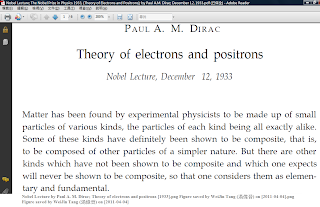Nobel Lecture; The Nobel Prize in Physics 1933, {Theory of Electrons and Positrons}; by Paul A.M. Dirac; December 12, 1933
From our theoretical picture, we should expect an ordinary electron, with positive energy, to be able to drop into a hole and fill up this hole, the energy being liberated in the form of electromagnetic radiation. This would mean a process in which an electron and a positron annihilate one another. The converse process, namely the creation of an electron and a positron from electromagnetic radiation, should also be able to take place. Such processes appear to have been found experimentally, and are at present being more closely investigated by experimenters.
Nobel Lecture by Paul A. M. Dirac; Theory of electrons and positrons [1933].png
湯偉晉 提供的教育服務 (Education Service offered by WeiJin Tang (湯偉晉)); Public blog (公開的部落格); Administrator (系統管理員): WeiJin.Tang@gmail.com; Cell phone: 0958-227-243 (Taiwan))
2011年4月4日 星期一
Nobel Lecture by Paul A. M. Dirac; Theory of electrons and positrons [1933]
訂閱:
意見 (Atom)

